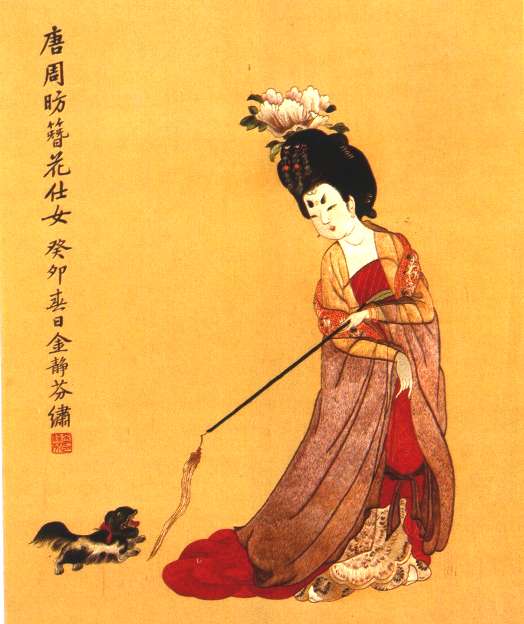Tang Beauty Once More(1)
Updated: 2007-05-10 16:21
The Ladies Wearing Flowers in Hair
More Stories about the Tang Dynsty are on the page52-59of
Desperate to catch up with the latest trend? Dotty for a curvaceous figure? Yes, fashion, a fulltime job, is the call of nature and the order of the day. But ever got hopeless and fed up with yourself? No wonder. Thick thighs, thin waist, large bust, thin face…It's fantastic but really non-realistic.
When time was old however, people hearkened to Tang women as the ultimate standard of beauty. Envy them? Follow this elegant Tang lady and read on.
"The Ladies Wearing Flowers in Hair" is a well-known ancient Chinese painting. It depicts the comfortable, gorgeous and happy life of noble women in the Tang Dynasty. The lady in a translucent red gown has olive-shaped eyebrows. She is playing with a pet dog and enjoying her leisure time.
Close Up
|
Readers' comments: Miaomiaohedy:In the Tang dynasty, lavishness was the rule of fashion; Yang Geifei, the favorite concubine of Emperor Tang Xuanzong and one of the Four Beauties in ancient China, was a plumpy beauty. Contribute your comments toForum |
As the capital of the Tang Dynasty (618-907), which marked a high point along the axis of the Chinese civilization, Chang'an was once the dreamland of fashion aficionados. It was where out-and-out beauty was one thousand years ago: the Tang beauty.
Much like the fashion world today, the trendsetters in the Tang Dynasty were court ladies, the wealthy women, celebrities, singers, and dancers. And the nomadic Xian Bei origin of the Tang rulers, to a certain degree, also decided their taste of beauty.
The Tang society was open, liberal and even a little bit "wild." Women would smarten themselves up in men's clothes and play polo on galloping horses. They were the earliest cross-dressers in Chinese history. The Tang fashion for women was not about lineal figure, but rather the search for novelty and love of beauty.
Women in Tang society enjoyed experimenting with ways to enhance their charms. Starting from the late Sui Dynasty (581-618) till the reign of Emperor Xuanzong of the Tang Dynasty, great changes initiated by the court had taken place on the criterion of beauty. Its influence reached as far as Japan, Korea, and Central Asia featuring a more liberal style, decorative dressing, lavish costumes, and a rotund figure.


